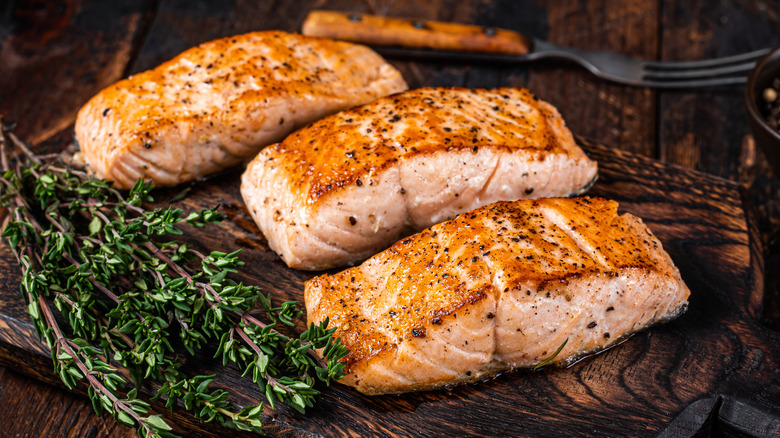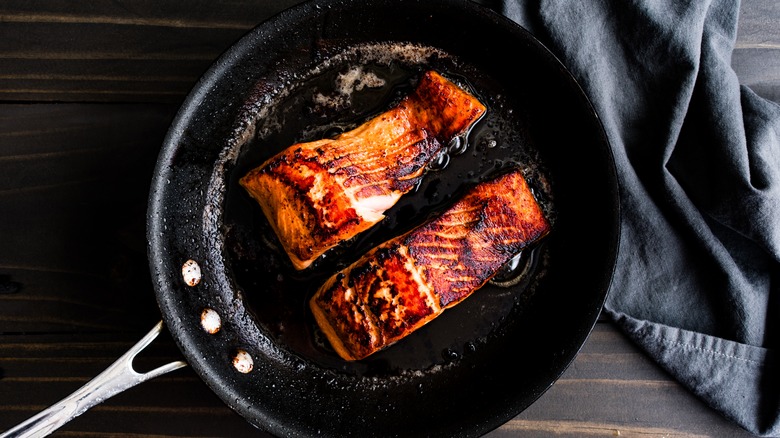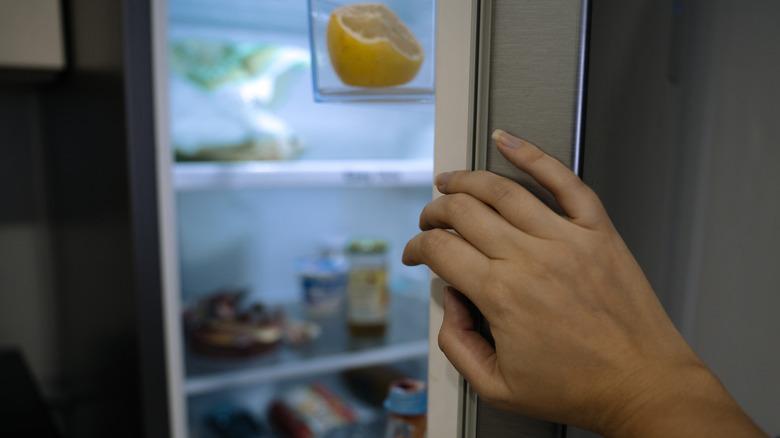Stop Rinsing Your Salmon Before Cooking (We're Serious)
Here's what really divides the country: Whether or not you should "wash" your proteins before cooking them. Salmon is a prime example. Sometimes, the fish can be a little slimy when you open it, but should you be rinsing it off in your sink?
The answer, definitively, is no (though we realize some of you will keep doing so, no matter what the experts say). Dr. Razieh Farzad, the seafood safety extension specialist for the Florida Sea Grant and an assistant professor of food science at the University of Florida, spoke to Southern Living about this topic. She concluded that rinsing salmon — or, indeed, any raw protein — risks the spread of contamination (including disease-causing bacteria) in your kitchen. If you want to get rid of any potentially harmful bacteria or parasites, simply cook the salmon to an internal temperature of 145 degrees Fahrenheit, per the USDA.
If you open your salmon and something about it smells off (for example, it has a sour aroma or just plain stinks), rinsing isn't going to help and may actually contaminate anything that water later touches. In this case, your salmon has probably gone bad and should be thrown out.
An easy method for cooking tasty, bacteria-free salmon
As mentioned, if you really want to kill any bacteria or contaminants that might be lurking in your salmon, you can just make sure it gets cooked to an internal temperature of 145 degrees Fahrenheit. While you can microwave your salmon, one of the better ways to cook it is a simple pan sear. As always, make sure you stick a meat thermometer into the thickest part of your filet when you're done cooking; as long as it reads 145 degrees Fahrenheit or over, you're good to go (This is especially important if you eschew this technique and choose the dishwasher method of cooking salmon instead). Almost all food-borne bacteria and illnesses in salmon, including Listeria, are killed at this temperature, so you certainly don't need to rinse it first.
As well as getting your fish to the USDA-recommended temperature required to kill any harmful bacteria and pathogens, pan-searing is the method we recommend for a few reasons. It's a really easy technique to master, and you don't need any fancy cooking utensils — just a pan and a spatula. This method of cooking salmon also makes a protein that can accompany any side, be it roasted potatoes or fried rice.
You have less than a week to eat your salmon leftovers
So you didn't rinse your salmon, you cooked it to 145 degrees Fahrenheit, and you've got some leftovers for the rest of the week. Or do you? First thing's first: Your cooked salmon should be refrigerated within two hours if it's been sitting at room temperature or within one hour if the ambient temperature is over 90 degrees Fahrenheit (As you're putting the fish away, be sure to disinfect any spice jars you used to prevent contamination). While you've killed the bacteria from the raw fish by cooking it, new bacteria can grow if the fish is left out for too long at temps higher than 40 degrees Fahrenheit. Also, make sure to store it in an airtight container.
Once the salmon is in the fridge, the cool temps will slow the growth of bacteria, but they can't stop it entirely. You have three to four days to eat the fish before it starts to go bad. After which, you should probably throw it out even if it seems "okay." Some signs that your salmon has, in fact, gone bad include: The texture becoming mushy and the fish developing a slime, or when you sniff it, it smelling super fishy and even taking on the scent of ammonia.


